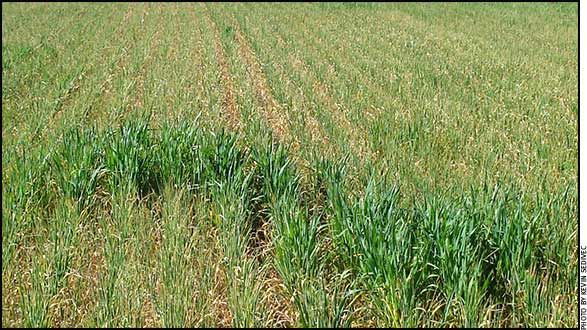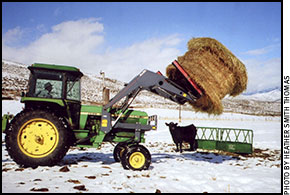
Oats are prone to nitrate toxicity and should be tested for nitrate toxicity, especially when subjected to stressful conditions, like drought.
Check Nitrate Levels in Forages
Test hay for nitrate levels before it’s fed to cattle.
Nitrate in forages can sometimes be a problem for cattle, according to Kevin Sedivec, professor of range science at North Dakota State University. Depending on growing conditions, nitrate levels may be excessive, and those levels remain high in stored feeds.
“Nitrate toxicity potential can occur in two scenarios. The first is annual forage crops harvested for hay. Nitrate levels can be excessive if the grower uses too much nitrogen fertilizer. If you fertilize the crop thinking in terms of what would be adequate for “X” amount of production and it’s a dry summer — and the crop has less biomass than expected — there will be elevated nitrogen levels,” he explains.
“I recommend testing soils for nitrogen and then add fertilizer as needed to achieve the production potential,” he says.

There is a cost associated with testing forages for nitrates, but a forage test is much cheaper than dead or sick cattle.
The second scenario occurs with certain crops that are known to be prone to nitrate toxicity.
“The main one would be oats; however, all cereal grain crops can become high in nitrates under stressful conditions. If you put up oats for hay, we recommend testing the hay — unless you had a really great summer with abundant moisture and plenty of biomass. It’s always a good idea, however, to test oat hay for nitrates,” says Sedivec.
Producers who plant brassicas like turnips, radishes, etc., for cover crops should be aware that in drought conditions these will also accumulate nitrogen. “Many producers graze those because they are hard to put up for hay. With stress conditions such as drought, I recommend testing brassica species for toxicity levels before you graze them,” he says.
“Toxic levels are usually associated with drought or early frost. Oats, barley, sorghum-Sudan grass, millet, etc., should always be tested if you harvest these species for hay. This is where we generally see toxic levels, following a stress period,” he says.
Other situations in which hay might be toxic are when it contains a lot of nitrate-accumulator weeds like kochia, Russian thistle and lamb’s-quarter, or even pigweed. “If people have weedy areas in the field they should not hay those areas, or keep those bales separate and test them. These weeds can also be deadly when grazed,” he says.
Barnyards and corrals may grow a lot of weeds. “It’s not uncommon to see problems when people move cattle into corrals where weeds have been growing all spring and summer. Lamb’s-quarter often grows thick in corrals and may be high in nitrates,” he explains.
When you send forage samples for testing, the lab results will tell you what the nitrate levels are — safe, moderately safe or toxic.
“If hay is high in nitrates, the next question is what to do with it. Even after it’s been stored a long time it is still toxic; the nitrates don’t volatilize out like prussic acid does in sorghum-Sudan grasses,” says Sedivec.
| 1,000 ppm or less — | Nitrate level safe under all conditions |
| 1,000-1,500 ppm — | Nitrate level safe for nonpregnant animals. For pregnant animals limit to 50% of total ration. |
| 1,500-2,000 ppm — | Feed is safe if limited to 50% of total dry-matter intake |
| 2,000-3,500 ppm — | Feed should be limited to 35%-40% total dry-matter intake |
| 3,500-4,000 ppm — | Limit to 25% of dry-matter intake. Do not feed to pregnant animals. |
| Above 4,000 ppm — | Do not feed! |
“It’s easier to deal with a moderately high-level feed, such as 2,000 parts per million (ppm). If you know you’ll have to blend a high-nitrate feed, test your other feeds so you can accurately figure out how to adequately dilute the nitrates. It costs a little to test, but it will be a lot cheaper than dead cattle.”

Editor’s Note: Heather Smith Thomas is a freelance writer and a cattlewoman from Salmon, Idaho.






